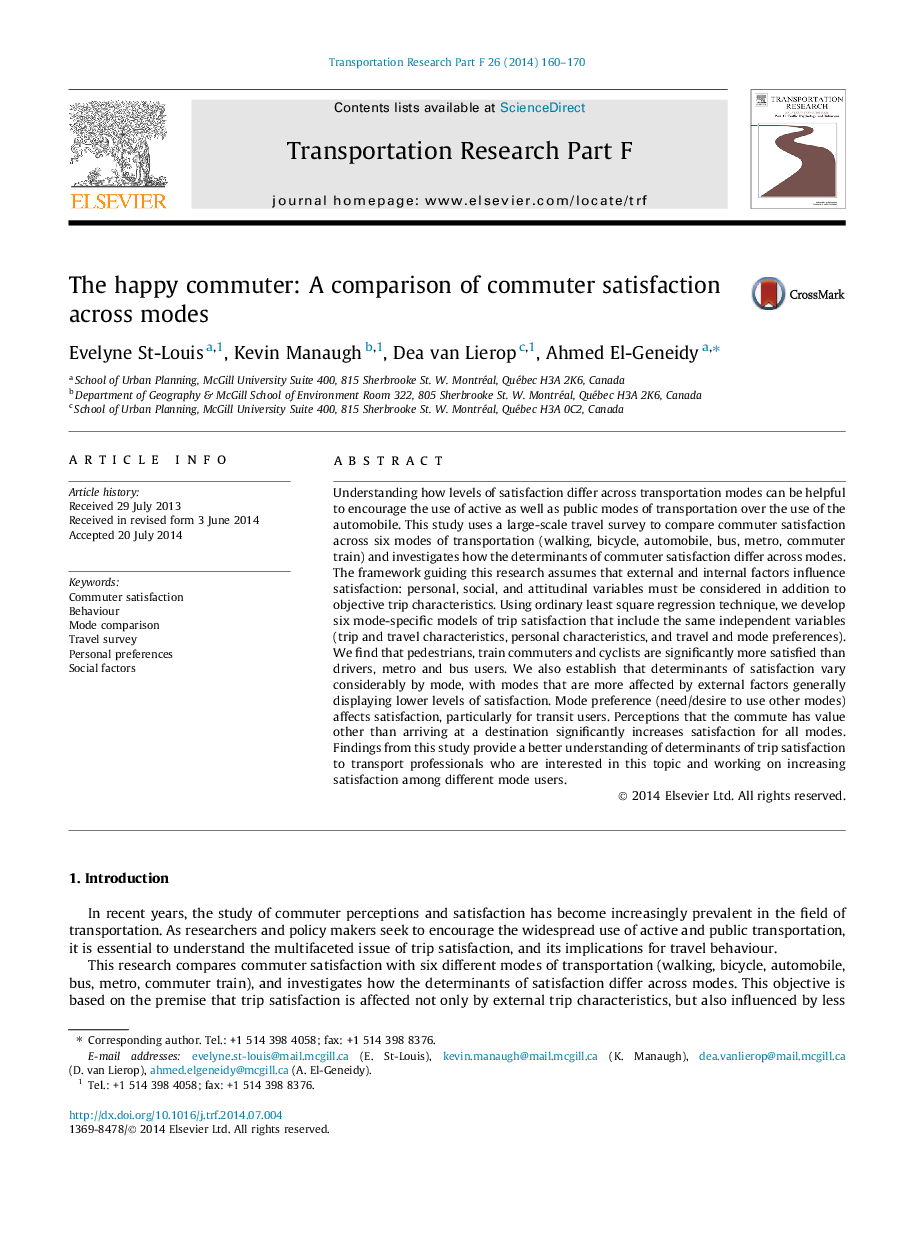| کد مقاله | کد نشریه | سال انتشار | مقاله انگلیسی | نسخه تمام متن |
|---|---|---|---|---|
| 10442963 | 915195 | 2014 | 11 صفحه PDF | دانلود رایگان |
عنوان انگلیسی مقاله ISI
The happy commuter: A comparison of commuter satisfaction across modes
ترجمه فارسی عنوان
مسافر خوشحال: مقایسه رضایت مسافرتی در حالت ها
دانلود مقاله + سفارش ترجمه
دانلود مقاله ISI انگلیسی
رایگان برای ایرانیان
کلمات کلیدی
رضایت مسافرتی، رفتار - اخلاق، مقایسه حالت، بررسی سفر تنظیمات شخصی، عوامل اجتماعی،
ترجمه چکیده
درک اینکه چگونه میزان رضایت در حالت های حمل و نقل متفاوت است، می تواند برای تشویق استفاده از حالت های فعال و همچنین حمل و نقل عمومی در استفاده از خودرو مفید باشد. این مطالعه با استفاده از یک بررسی بزرگ در مورد سفر به مقایسه رضایت مسافرتی در شش حالت حمل و نقل (راه رفتن، دوچرخه، خودرو، اتوبوس، مترو، قطار رفت و آمد) و بررسی چگونگی تعیین عوامل رضایت مسافرتی در حالت ها. چارچوب هدایت کننده این تحقیق فرض می کند که عوامل خارجی و داخلی بر رضایت تاثیر می گذارد: متغیرهای شخصی، اجتماعی و نگرشی باید علاوه بر ویژگی های سفر عینی، مورد توجه قرار گیرند. با استفاده از تکنیک رگرسیون حداقل مربع، ما شش مدل خاص رضایت از سفر را که شامل همان متغیرهای مستقل (ویژگی های سفر و سفر، ویژگی های شخصی، و ترجیحات سفر و حالت) است، توسعه می دهیم. ما می بینیم که عابران پیاده، مسافران قطار و دوچرخه سواران نسبت به رانندگان، مترو و کاربران اتوبوس نسبت به رانندگان، مترو و اتوبوس بسیار رضایت بخش هستند. ما همچنین تعیین می کنیم که تعیین کننده های رضایت به طور قابل ملاحظه ای با حالت متفاوت هستند، در حالی که حالت هایی که بیشتر عوامل خارجی تحت تاثیر قرار می گیرند، معمولا سطوح پایین رضایت را نشان می دهند. ترجیح حالت (نیاز / تمایل به استفاده از حالت های دیگر) بر رضایت، به ویژه برای کاربران حمل و نقل تاثیر می گذارد. ادراکاتی که رفت و آمد به ارزش جز به رسیدن به مقصد قابل توجه است، رضایت را برای همه حالت ها افزایش می دهد. یافته های این مطالعه، درک بهتر عوامل تعیین کننده رضایت از سفر به متخصصان حمل و نقل که علاقه مند به این موضوع هستند و کار بر روی افزایش رضایت در میان کاربران مختلف حالت را ارائه می دهند.
موضوعات مرتبط
علوم انسانی و اجتماعی
روانشناسی
روان شناسی کاربردی
چکیده انگلیسی
Understanding how levels of satisfaction differ across transportation modes can be helpful to encourage the use of active as well as public modes of transportation over the use of the automobile. This study uses a large-scale travel survey to compare commuter satisfaction across six modes of transportation (walking, bicycle, automobile, bus, metro, commuter train) and investigates how the determinants of commuter satisfaction differ across modes. The framework guiding this research assumes that external and internal factors influence satisfaction: personal, social, and attitudinal variables must be considered in addition to objective trip characteristics. Using ordinary least square regression technique, we develop six mode-specific models of trip satisfaction that include the same independent variables (trip and travel characteristics, personal characteristics, and travel and mode preferences). We find that pedestrians, train commuters and cyclists are significantly more satisfied than drivers, metro and bus users. We also establish that determinants of satisfaction vary considerably by mode, with modes that are more affected by external factors generally displaying lower levels of satisfaction. Mode preference (need/desire to use other modes) affects satisfaction, particularly for transit users. Perceptions that the commute has value other than arriving at a destination significantly increases satisfaction for all modes. Findings from this study provide a better understanding of determinants of trip satisfaction to transport professionals who are interested in this topic and working on increasing satisfaction among different mode users.
ناشر
Database: Elsevier - ScienceDirect (ساینس دایرکت)
Journal: Transportation Research Part F: Traffic Psychology and Behaviour - Volume 26, Part A, September 2014, Pages 160-170
Journal: Transportation Research Part F: Traffic Psychology and Behaviour - Volume 26, Part A, September 2014, Pages 160-170
نویسندگان
Evelyne St-Louis, Kevin Manaugh, Dea van Lierop, Ahmed El-Geneidy,
